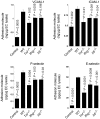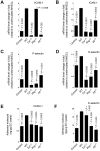Regulation of endothelial cell adhesion molecule expression by mast cells, macrophages, and neutrophils
- PMID: 21264293
- PMCID: PMC3021513
- DOI: 10.1371/journal.pone.0014525
Regulation of endothelial cell adhesion molecule expression by mast cells, macrophages, and neutrophils
Abstract
Background: Leukocyte adhesion to the vascular endothelium and subsequent transendothelial migration play essential roles in the pathogenesis of cardiovascular diseases such as atherosclerosis. The leukocyte adhesion is mediated by localized activation of the endothelium through the action of inflammatory cytokines. The exact proinflammatory factors, however, that activate the endothelium and their cellular sources remain incompletely defined.
Methods and results: Using bone marrow-derived mast cells from wild-type, Tnf(-/-), Ifng(-/-), Il6(-/-) mice, we demonstrated that all three of these pro-inflammatory cytokines from mast cells induced the expression of vascular cell adhesion molecule-1 (VCAM-1), intercellular adhesion molecule-1 (ICAM-1), P-selectin, and E-selectin in murine heart endothelial cells (MHEC) at both mRNA and protein levels. Compared with TNF-α and IL6, IFN-γ appeared weaker in the induction of the mRNA levels, but at protein levels, both IL6 and IFN-γ were weaker inducers than TNF-α. Under physiological shear flow conditions, mast cell-derived TNF-α and IL6 were more potent than IFN-γ in activating MHEC and in promoting neutrophil adhesion. Similar observations were made when neutrophils or macrophages were used. Neutrophils and macrophages produced the same sets of pro-inflammatory cytokines as did mast cells to induce MHEC adhesion molecule expression, with the exception that macrophage-derived IFN-γ showed negligible effect in inducing VCAM-1 expression in MHEC.
Conclusion: Mast cells, neutrophils, and macrophages release pro-inflammatory cytokines such as TNF-α, IFN-γ, and IL6 that induce expression of adhesion molecules in endothelium and recruit of leukocytes, which is essential to the pathogenesis of vascular inflammatory diseases.
Conflict of interest statement
Figures





References
-
- Vestweber D, Blanks JE. Mechanisms that regulate the function of the selectins and their ligands. Physiol Rev. 1999;79:181–213. - PubMed
-
- Takahashi K, Takeya M, Sakashita N. Multifunctional roles of macrophages in the development and progression of atherosclerosis in humans and experimental animals. Med Electron Microsc. 2002;35:179–203. - PubMed
Publication types
MeSH terms
Substances
Grants and funding
- HL36028/HL/NHLBI NIH HHS/United States
- P01 HL036028/HL/NHLBI NIH HHS/United States
- HL60942/HL/NHLBI NIH HHS/United States
- K99 HL094706/HL/NHLBI NIH HHS/United States
- R01 HL060942/HL/NHLBI NIH HHS/United States
- HL094706/HL/NHLBI NIH HHS/United States
- HL81090/HL/NHLBI NIH HHS/United States
- R01 HL053993/HL/NHLBI NIH HHS/United States
- R01 HL088547/HL/NHLBI NIH HHS/United States
- HL88547/HL/NHLBI NIH HHS/United States
- HL53993/HL/NHLBI NIH HHS/United States
- R00 HL094706/HL/NHLBI NIH HHS/United States
- R01 HL081090/HL/NHLBI NIH HHS/United States
LinkOut - more resources
Full Text Sources
Other Literature Sources
Molecular Biology Databases
Miscellaneous

